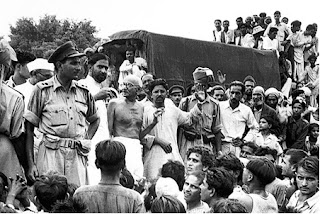1. First session of the Indian National Congress (INC) was conducted in Bombay from 28 to 31 December 1885. The second session of INC was presided by
a) Badruddin Tyabji
b) Womesh Chandra Bonnerjee
c) Dadabhai Naoroji
d) William Wedderburn
2. Who among the following had popularized the festivals associated with Ganesh and Shivaji during the national movement?
a) Vinayak Damodar Savarkar
b) Lala Lajpat Rai
c) Jyotirao Govindrao Phule
d) Bal Gangadhar Tilak
3. Who had launched the Bardoli satyagraha in February 1928?
a) Sardar Vallabhai Patel
b) Mohandas Karamchand Gandhi
c) Vinoba Bhave
d) None of the above
4. Who among the following was a leader of the Indian militant peasant movement Eka (unity) Movement?
a) Madari Pasi
b) Alluri Sitarama Raju
c) Laxman Nayak
d) Uyyalawada Narasimha Reddy
5. Who was the most prominent leader of Tamralipta Jatiya Sarkar?
a) Ganesh Ghosh
b) Satish Chandra Samanta
c) Dinesh Chandra Gupta
d) Bagha Jatin
6. Who was the Nawab of Bengal when the Battle of Buxar took place?
a) Mir Qasim
b) Siraj-ud-Daulah
c) Mir Jafar
d) Shuja ud daula
7. Who among the following has won Bharat Ratna, India’s highest civilian honour and Nishan-e-Pakistan, Pakistan’s highest civilian honour?
a) Morarji Desai
b) Lal Bahadur Shastri
c) Vallabhbhai Jhaverbhai Patel
d) Jawaharlal Nehru
8. When did Choudhary Rahmat Ali coin the word Pakistan?
a) 1930
b) 1933
c) 1940
d) 1942
9. Gandhiji had launched Champaran Satyagrah in 1917 fora) Uplift of Depressed Class of India
b) Unifying Hindu Society
c) Protesting against the injustice meted out to Indigo farmers
d) All of the above
10. Who among the following was an important Muslim leader of the Swadeshi Movement?
i. Abdul Halim Guznavi
ii. Liakat Hossain
iii. Liakat Ali Khan
a) i
b) ii
c) i and ii
d) i, ii and iii
Answers
1- c
2- d, Before the advent of the Mahatma Gandhi, Bal Gangadhar Tilak (1856-1920) was the tallest Congress leader.
3- a
4- a, Bal Gangadhar Tilak was called the "father of Indian unrest" by Sir Ignatius Valentine Chirol, a British journalist.
Madari Pasi belonged to the ‘untouchable’ Pasi caste that had been classified by the British administration as a “criminal” caste. He was born in the village of Mohanjganj in Uttar Pradesh’s Hardoi district in 1860.
5- b
6- a
7- a
8- b, In 1933, Choudhary Rahmat Ali published a pamphlet, "Now or Never: Are We to Live or Perish for Ever?" coining the word Pakistan for the first time.
9- c
10- c



